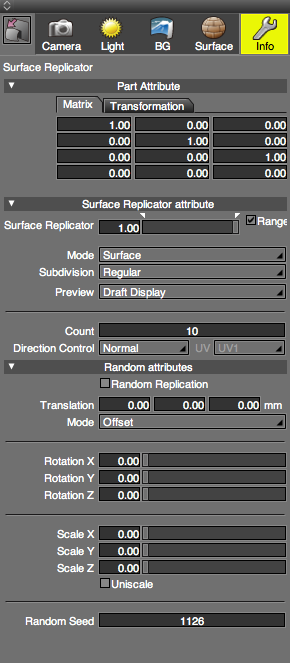Surface Replicator Information
These settings are displayed when a surface replicator is selected.

Part Attribute Settings
For details on the Part Attribute Settings, please refer to Replicator Information.
Path Replicator Attribute Settings
- Path Replicator
- Specifies the joint value of the surface replicator. The range of values can be restricted using the joint limits (triangle icons) above the slider control.
When Surface or Surface (Uniformity) is selected from the Mode pop-up menu, - Range
- Select this checkbox to enable the upper and lower joint limits.
Deselect this option to disable joint limits. - Mode
- Specifies how replicas are distributed over the surface. Choose Vertex, Edge, Face Center, Surface, or Surface (Uniformity).
The object replicated is temporarily converted to a polygon mesh to calculate its base point of reference. - Subdivision
- Specifies the level of subdivision used when the object to replicate is converted temporarily to a polygon mesh.
The level of subdivision affects the placement of replicas. - Preview
- Specifies the method for displaying the replicated objects. This does not affect rendering.
- Count
- Specifies the number of replicas created. This option becomes available when Surface or Surface (Uniformity) is selected from the Mode pop-up menu.
- Direction Control
- Specifies the direction, relative to the base point of reference, to use when placing replicas.
- UV Pop-up Menu
- Specifies the UV layer to use for the surface when U Direction or V Direction is selected from the Direction Control pop-up menu.
Random Attributes
- Random Replication
- When selected, if multiple child objects are inside the path replicator part, they are extracted for replication randomly.
- Translation
- Specifies the maximum distance to translate each replica in the X, Y, and Z directions.
- Mode
- Select either Offset or Displacement to determine how the random Translation distance is measured.
- Rotation X, Y, Z
- Specifies the range of random rotation done in each of the XYZ axes.
- Scale X, Y, Z
- Specifies the ratio of random scaling done in each of the XYZ axes (a value of 1.0 results in scaling between 0 and 200%).
- Uniscale
- When selected, randomly generated replicas are scaled uniformly along their X, Y and Z axes.
- Random Seed
- Specifies the value used for the random calculation. Changing this value will change the random replication.